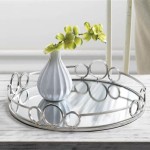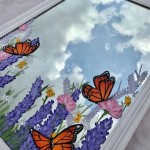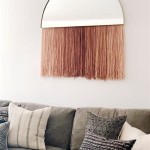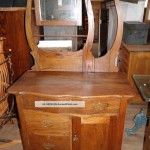Spray Painting A Gold Mirror Silver
Transforming a gold mirror frame into a silver one through spray painting is a cost-effective and relatively simple do-it-yourself project. The execution, however, necessitates meticulous planning, preparation, and execution to achieve a professional-looking, durable finish. This article outlines the step-by-step process, emphasizing the essential materials, surface preparation techniques, spray painting best practices, and post-painting considerations required for a successful transformation.
The appeal of changing the color of a mirror frame often stems from shifting aesthetic preferences, interior design updates, or the need to match existing décor. Gold, while a classic and elegant finish, may not always complement a specific room's color scheme or stylistic direction. Silver, being a more neutral and versatile metallic tone, can often integrate seamlessly into a wider range of environments. Furthermore, repurposing an existing gold mirror avoids the expense and potential waste associated with purchasing a new silver-framed mirror.
Before embarking on the project, it is crucial to gather all the necessary materials and tools. These typically include a well-ventilated workspace, drop cloths or protective sheeting, cleaning supplies (such as degreaser and microfiber cloths), sandpaper (various grits ranging from coarse to fine), painter's tape, primer (specifically formulated for the material of the mirror frame), spray paint (silver metallic with the desired sheen), and optionally, a clear coat sealant for added protection and durability. The specific types of sandpaper, primer, and spray paint will be determined by the material of the mirror frame (wood, plastic, metal) and the desired final aesthetic.
The success of any spray painting project hinges largely on the quality of the surface preparation. Proper preparation ensures optimal adhesion of the primer and paint, preventing peeling, chipping, and uneven finishes. Neglecting this crucial step often leads to unsatisfactory results and the need for rework, ultimately increasing the time and effort required for the project.
Key Point 1: Thorough Surface Preparation
The first step is to thoroughly clean the mirror frame. This involves removing any dirt, dust, grease, or existing imperfections that could interfere with the adhesion of the primer and paint. A mild degreaser or household cleaner can be used, followed by wiping the frame with a clean, damp microfiber cloth. Allow the frame to dry completely before proceeding.
Next, inspect the frame for any existing damage, such as scratches, dents, or chips. These imperfections should be addressed before priming. Minor scratches can often be smoothed out with fine-grit sandpaper (220-320 grit). Deeper dents or chips may require filling with wood filler (for wooden frames) or auto body filler (for metal or plastic frames). Allow the filler to dry completely according to the manufacturer's instructions, and then sand it smooth until flush with the surrounding surface.
Sanding the entire frame is a critical step in preparing the surface for painting. Sanding creates a slightly roughened surface, providing a better "tooth" for the primer to grip onto. Begin with a medium-grit sandpaper (120-180 grit) to lightly scuff the existing finish. Avoid sanding too aggressively, as this can damage the frame. After sanding, wipe the frame clean with a tack cloth to remove all sanding dust. This is crucial, as any remaining dust particles can create imperfections in the final finish.
Protect the mirror glass from overspray by carefully masking it off with painter's tape. Ensure the tape is applied securely and smoothly, covering all edges of the glass. For added protection, consider covering the glass with newspaper or plastic sheeting, securing it in place with more painter's tape. Precise masking is essential for achieving clean, crisp lines and preventing unwanted paint on the mirror surface.
The choice of primer is highly dependent on the material of the mirror frame. For wooden frames, a wood primer is recommended. For metal frames, a metal primer is essential to prevent rust and ensure proper adhesion. For plastic frames, a plastic primer, often formulated with an adhesion promoter, is necessary. Apply the primer in thin, even coats, following the manufacturer's instructions. Allow each coat of primer to dry completely before applying the next.
Priming serves several important functions. It creates a uniform surface for the paint to adhere to, it blocks the existing color of the frame from bleeding through the new paint, and it helps to prevent the paint from being absorbed into the frame. Applying two or three thin coats of primer is generally recommended for optimal results.
Key Point 2: Spray Painting Technique
Once the primer is completely dry, application of the silver metallic spray paint can commence. Before starting, shake the spray paint can vigorously for at least two minutes to ensure the paint is properly mixed. This is essential for achieving an even color distribution and preventing clogs in the spray nozzle.
Always test the spray paint on a piece of scrap material (such as cardboard) before applying it to the mirror frame. This allows you to adjust the spray nozzle and familiarize yourself with the spray pattern and paint flow. It also helps to identify any potential issues with the paint, such as clogs or sputtering.
Hold the spray paint can approximately 8-10 inches away from the mirror frame and apply the paint in thin, even coats. Use a smooth, consistent sweeping motion, overlapping each pass slightly. Avoid spraying too much paint in one area, as this can lead to runs and drips. It is always better to apply several thin coats than one thick coat.
Metallic spray paints often require multiple coats to achieve full coverage and a consistent metallic sheen. Allow each coat to dry completely before applying the next. The drying time will vary depending on the specific paint and environmental conditions (temperature and humidity). Consult the manufacturer's instructions for recommended drying times.
Pay particular attention to edges and corners, ensuring they are evenly coated. These areas are often prone to paint buildup, so apply the paint sparingly and carefully. If necessary, use a small paintbrush to touch up any hard-to-reach areas.
Continue applying thin, even coats of spray paint until the desired level of coverage and metallic sheen is achieved. Typically, two to three coats are sufficient. Remember to allow each coat to dry completely before applying the next.
Key Point 3: Post-Painting Considerations and Sealing
After the final coat of silver spray paint has dried completely, carefully remove the painter's tape and protective materials from the mirror glass. Use a sharp utility knife or razor blade to score along the edge of the tape before peeling it off. This helps to prevent the paint from chipping or peeling along with the tape.
Inspect the painted frame for any imperfections, such as runs, drips, or missed spots. If necessary, use fine-grit sandpaper (400-600 grit) to lightly sand down any imperfections. Then, touch up the affected areas with more spray paint. Allow the touch-up paint to dry completely before proceeding.
Applying a clear coat sealant is highly recommended to protect the silver metallic paint and enhance its durability. A clear coat sealant will also provide a more even sheen and make the frame easier to clean. Choose a clear coat sealant that is compatible with the spray paint you used. Apply the sealant in thin, even coats, following the manufacturer's instructions.
Allow the clear coat sealant to dry completely before handling or hanging the mirror. The drying time will vary depending on the specific sealant and environmental conditions. Consult the manufacturer's instructions for recommended drying times. It is generally recommended to allow the frame to cure for at least 24-48 hours before handling it extensively.
Proper ventilation is essential throughout the entire spray painting process, from surface preparation to sealing. Spray painting should be done in a well-ventilated area, such as outdoors or in a garage with the doors and windows open. Wear a respirator or dust mask to protect yourself from inhaling paint fumes and dust particles.
Safe disposal of used spray paint cans and other materials is crucial. Consult your local regulations for proper disposal methods. Empty spray paint cans can often be recycled, while leftover paint should be disposed of at a hazardous waste collection facility.
By following these detailed steps and taking the necessary precautions, individuals can successfully transform a gold mirror frame into a silver one, achieving a professional-looking and durable finish that complements their desired aesthetic.

How To Paint A Mirror Frame Gold Easily In Two Steps

How To Paint A Mirror Frame We Moved Visit Ashleyburk Com

How To Paint A Mirror Frame Gold Remodelando La Casa

Spray Painted Gold Yard Mirror How To Paint A Frame

How To Paint A Mirror Frame Gold Remodelando La Casa

How To Paint Gold Mirror Frame Keeping The Ornate Features Vickymyerscreations

How Do You Distress A Gold Mirror Frame Hometalk

Gold Spray Paint Diy S For Your Home The Scarlett Social

12 Techniques To Painting Antique Mirrors Hallstrom Home

Give The Look Of Patina Gold With Paint Artsy Rule








